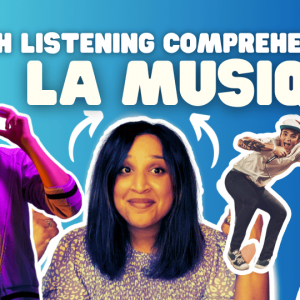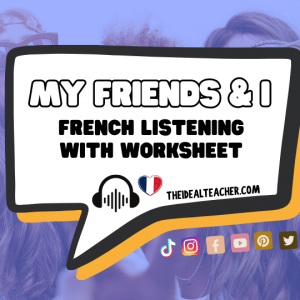 Fun Pre-Reading and Post-Reading Activities for All Language Classrooms
Fun Pre-Reading and Post-Reading Activities for All Language Classrooms
I love language lessons which involve an element of reading. This is because there are so many opportunities for learning and improving language acquisition with topic-related texts. Reading activities are the perfect starting point to learn rich topic-related vocabulary (adjectives, nouns, verbs etc), pick up new grammar structures, steal ‘star phrases’ and ultimately improve comprehension and improve language acquisition skills.
According to Moeller & Meyer (1995), reading, even at a slow pace exposes students to more sentences, grammar, and new vocabulary per minute than the average short class, TV show, or song. So, if you are in a rut with how you present and teach your reading activities, get an innovative injection of pre-reading activities and post-reading activities below.
BEFORE YOU READ ON, HAVE YOU SUBSCRIBED TO MY YOUTUBE CHANNEL WITH FREE FRENCH & GERMAN LISTENING, GRAMMAR AND VOCAB RESOURCES? IF NOT, PLEASE DO SUBSCRIBE TO MY YOUTUBE CHANNEL HERE.
Who Should Use These Awesome Reading Activities?
All of these reading ideas for the language classroom are low-prep and no-prep reading activities. Use them in any post-beginner language classroom, including French, German, English and Spanish lessons.
The aim of these 21 must-use reading activities is to get your language students focused and in the mood for learning. However, as the teacher, you will need to be in charge of providing a great text, to bring the reading ideas below to life. This could range from one paragraph for beginners, to a few chunky paragraphs for intermediate learners, to an extended text for advanced students.
Pre-Reading Activities
- “Find The Word” Reading Aloud Activity (Pair Work)
Put students in pairs and provide them with one copy of a text. Have a secret list of words at the ready and call them out, at random, one at a time. Allow time for students to scan the text for the word they hear. The first person in the pair to point correctly at the word in the text gets a point. Make sure you set sound level rules, as well as clear guidance on how the class should be silent ready for the next round. - “Reading Aloud” Task (Pair Work / Small Group Work)
Provide students with a ‘chunky’ text split into paragraphs. Advise that each student in the pair/group must read one paragraph aloud. If the person has an issue pronouncing a word, he/she must circle it and if they come across a word they don’t understand, they must underline it. Allow students to discuss their problem areas in pairs and then in fours. Go around making a note of the common issues and write on the board with whole group choral work and discussion at the end. - “Team Reading Aloud” – Pronunciation Reading (Whole Group)
Split the classroom in two and assign all students in each team a number and repeat (using the same numbers) with the other team. Provide students with a ‘chunky’ text for reading and set each team off with 20 points. The aim of the activity is to be the team to finish with the most points after the text has been read. Flip a coin to see which team begins. Randomly choose a number and that student must begin reading. If the other team spots a pronunciation error, as the student is reading, a member of the team must put their hand up. If all others in the team agree, everyone’s hand must go up – this should keep everyone focused. If they spot a genuine pronunciation error, they can help the reader make the correction receive a point (provide support if their ‘help’ isn’t quite accurate). However, if the whole team has made a mistake and picked a word that was correctly pronounced, they will lose a point and the other team will gain a point. Each time an error in pronunciation is correctly spotted, swap the reading team. Deduct points for talking or misbehaviour. - “The Last Word” Reading Activity (Pair / Small Group Work)
As a group, the team chooses how many words each student should read. For example, 3 words. In addition, allow students to choose the order of reading. Once the students begin reading, the winner is the student who follows the rules and manages to be the person to read the last word. - “Avoid The Line” – Reading Aloud Activity (Pair / Small Groups) When you prepare a text, underline words at random. Students start with 5 points. Each student must read 5 words at a time, but must avoid actually saying any words that have been underlined. Should they read the underlined word by accident, they lose a point. Students with with the most points at the end of the reading activity win.
- “Bratwurst” Name” – Reading Out Aloud Activity (Small Groups) One student begins and after a pre-determined number of words or sentences, they shout “Bratwurst / Pain au chocolat / Churros” (etc, depending on the language you teach) plus the name of someone in the group i.e. Bratwurst Laura. This person must then continue where the other reader left off. Award points at the beginning and if someone loses focus and doesn’t know where the previous reader was, they lose a point.
- Teacher Names – Reading Activity Out Aloud (Whole Group)
Split the class in two and assign 5 points to each team. Then, model pronunciation of the text by reading it out aloud. At random intervals, instead of reading the next word, call out a student’s name and that student must read the word that their name was replaced by. If the chosen student doesn’t respond without being prompted within 5 seconds of stopping, the team loses a point. Perfect for getting students to focus on reading activities. As well as getting them to pronounce the words you think they might find tricky or could do with knowing. In addition, you could get students to create a list of vocabulary replaced by students names and translate/make sentences with, as a post-reading activity. - “Wie bitte?” – Reading Aloud Activity (Small Groups)
Put students into threes, taking it in turns to read a sentence. As they read, a student must make a mistake, on purpose. This could include: wrong words, incorrect genders, wrong pronunciation, incorrect verb ending etc. When a listener hears a mistake, they must say ‘Wie bitte?’ ‘oh la la’ or ‘Oye’, depending on the language you teach. If they can correct the mistake, they win a point and if they can’t correct the error, the reader gets a point. This can also be done as a whole group with students standing up when you make a mistake. The last one to stand up is ‘out’. However, make sure you give students who are out a little task to do until the end of the game. - Spontaneous Reading Activity (Whole Group)
One student starts reading at random and can read a maximum of one sentence. As soon as they end their sentence, another student must begin reading. If no-one starts within a second, or more than one person starts reading, the whole group must go back to the beginning. Starting with another student reading the first sentence. You can vary this by getting learners to translate the text as they read the sentence or change the person (thus the verbs and possessive adjectives etc). Keep going back to the beginning until the reading out aloud activity has been completed as per the rules. - Find …. – Skim Reading Activity (Alone)
As soon as you give students a reading text, provide them with a list of words in L1 (native language) to find in L2 (language being learnt) in the text. This could be all masculine nouns, all verbs, all adjectives, all words beginning with ‘a’. They could either highlight the words in the text or underline the words. - Find the Synonym – Skim Reading Activity (Individual)
As with reading activity 10, give students a reading text and provide them with a list of words in L2. They must find and note down the synonyms they find in the text. - Be A Presenter – Reading Aloud (Pairs)
Have iPads or laptops available, enough for one between two. Have students paste a copy of your text into cue prompter with one student sitting with their back to the laptop and the other person reading aloud. The presenter must read clearly with accurate pronunciation and the listener must fill in the gaps on their sheet as they are listening with the words they hear. They may not ask the presenter to spell any word. Instead, if they have gaps at the end, the presenter must re-read (the whole lot or just the sentence, depending on how you’re feeling on the day). - Guess The Rule Reading Aloud (Whole Group Game)
The teacher begins by reading every other word from the text in order. Students must put their hands up to guess the rule. Allow individual students in the group to do the same by reading aloud. The rest of the group must try to guess the rule. Students can only start to put their hands up after the reader has read at least 1/3 or 1/2 of the text. Let the students be creative with their rules. The teacher could also re-read and do the same with adjectives, nouns, verbs etc to make the reading activity more grammar based. It’s perfect to get reluctant and shy students reading. - Running Dictation Speaking Reading Activity (Small Groups)
This works better with shorter texts or splitting a whole text into paragraphs, which each team is responsible for. Put enough copies of the texts up outside the classroom with a number on each. Assign each team a number. Advise the aim is for students to be the first team to communicate the text from their corresponding paragraph outside the classroom, without cheating. Students must take it in turns to read a sentence in sequence from their paragraph, and be the first team to finish communicating and writing the paragraph down on a sheet of paper.
RULES: a) only one student can be out of their seat at a time, b) students must not run or shout, c) students must also take it in turns to write the sentences on the paper, d) learners are not allowed to spell any words, but they are allowed to go back as many times as they need to to re-read the sentence, e) the rest of the group must work as a team to ensure the words are spelled accurately and the grammar is also correct. - Gap-Fill Transcript Dictation Reading Activity (Individual)
Provide students with a copy of the text, with gaps. I suggest three forms, one with verbs missing, the second with nouns missing and the third with adjectives missing. Distribute the sheets so they have people around them who had the same sheet. The students must individually fill in the words as they listen. You could read again if necessary. Once finished, get learners to check they have spelled the words correctly by discussing (not showing!) with their neighbours. - Wrong Words Reading Activity (Individual)
The teacher provides students with a copy of the text with a selection of incorrect words. As they listen to the text being read, they must highlight the word they hear that is incorrect. Go through a second time, and this time, the students must write in the correct words. This will give the students an idea of the text before they do any comprehension activities. - Key Word Bingo – Vocabulary Based Reading Activity (Individual)
From the text, read 5-20 words (dependent on text length) at random in L2. Students must cross them off as they hear them.
Post-Reading Activities
- True or False? – Post-Reading Activity (Alone)
Once students have read the text through properly, allow them 5 minutes to create a list of true or false statements. These can be given to a peer to answer if time allows. - Summarise The Text – Post Reading Activity (Individual)
Once students have read the text, advise that they must underline the key messages, depending on the size of the text. I recommend advising a maximum number. Students must then combine and re-word these ideas to summarise the whole text in a set number of words. - Re-write The Text – Reading Activity (Alone)
After reading (and depending on the length of the whole text), students must re-write the text in the first, second or third person singular. If the text is long, then advise that they should pick out a certain number of paragraphs. - Walking Text – Reading Comprehension Activity (Individual)
Instead of getting students to read the texts in their seats, print out a few copies. Ensure the text is enlarged and in paragraphs with line numbers. Then, chop them up with numbers, indicating the paragraph number on each and stick them around the room. I recommend doing a few copies to ensure that no more than 2 students are at one paragraph of text at a time. Give them some pre-printed comprehension questions to answer as they go around. You can support learners who need it with an indication of the paragraph number, correlating to the question, written on their sheet.
Want these ideas in a handy downloadable format? Download my 21 must-use reading activities for all language classrooms PDF here:
Did you enjoy this reading activities for the language classroom post? If so, be sure to check out these posts to improve language acquisition here too:
Fun Games for the MFL Classroom
Spontaneous Speaking with Video Clips in the Language Classroom
Want to keep up-to-date with the latest content? Sign Up to the Ideal Teacher’s Exclusive Mailing List.
BEFORE MOVING ON, HAVE YOU SUBSCRIBED TO MY YOUTUBE CHANNEL? IT CONTAINS FREE FRENCH & GERMAN LISTENING, GRAMMAR AND VOCAB RESOURCES. IF NOT, PLEASE SUBSCRIBE TO MY YOUTUBE CHANNEL HERE.
JOIN ME ON MY SOCIALS FOR MORE FAB TEACHING CONTENT >>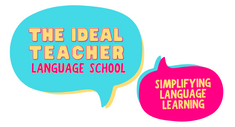
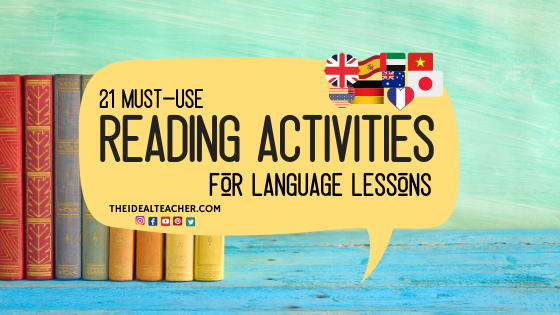
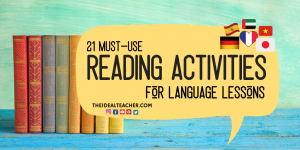 Fun Pre-Reading and Post-Reading Activities for All Language Classrooms
Fun Pre-Reading and Post-Reading Activities for All Language Classrooms
